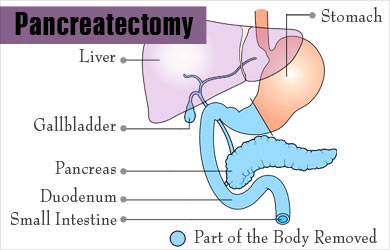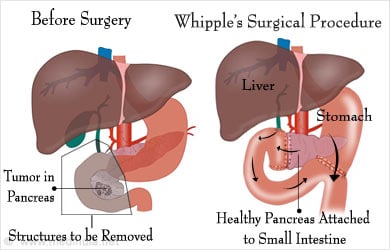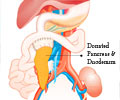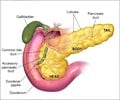About Pancreas
The pancreas is an important organ of the body. Its functions not only include secreting digestive juices, but it also secretes insulin and glucagon that are important for the control of blood sugar.
The pancreas has an elongated shape and lies just below the stomach. It has the following parts – head with uncinate process, neck, body and tail. The head is located in the curve of the duodenum, the first part of the intestine, and secretes digestive juices in this part. The tail is located close to the spleen.
What is Pancreatectomy?
Pancreatectomy is a surgical procedure for removing the entire or part of the pancreas.

What are the Conditions that Require Pancreatectomy?
Conditions affecting the pancreas sometimes require pancreatectomy. These include:
- Suspected, or proven cancer of the pancreas
- Lesions of the pancreas that could become cancerous
- Chronic pancreatitis that does not respond to conservative or endoscopic treatments
- Severe trauma to the pancreas
- Certain cysts in the pancreas
What are the Types of Pancreatectomies?
Pancreatectomy is classified into several types:
- Open or laparoscopic pancreatectomy
In open pancreatectomy, an open surgery is carried out to remove the pancreas while in laparoscopic pancreatectomy, a laparoscope is used for the surgery.
A laparoscopic surgery is done through three or four small incisions in the abdomen. Initially, carbon dioxide is introduced into the abdomen. The laparoscope is introduced through one of the incisions, which has a source of light and a small camera at the end. The pictures from the camera can be seen on a screen. Surgical instruments are introduced through the incisions and the surgery is carried out. Laparoscopic surgery results in reduced hospital stay and complications as compared to the open procedure. However, complicated procedures may not be possible through a laparoscope.
Robotic surgery is another new avenue that has improved the outcome in patients requiring pancreatectomy. It provides 3-dimensional imaging and allows a better view for surgery. It also allows the surgeon to use his hands comfortably. It is often used for more complicated surgeries where laparoscopy is not an option. However, the cost-effectiveness of the procedure should also be kept in mind.
- Partial or total pancreatectomy
Surgical removal of the whole pancreas is called total pancreatectomy. Sometimes, a procedure called islet cell autotransplantation is combined with total pancreatectomy. In this procedure, islet cells that produce insulin are removed from the surgically excised pancreas and re-introduced into the liver of the patient.
When a part of the pancreas is removed, the surgery is called partial pancreatectomy. Due to its proximity to organs like the duodenum, stomach and spleen, some parts of these organs may need to be surgically removed.
Partial pancreatectomy is of several types:
- Whipple procedure: In this procedure, the head of the pancreas is excised with a part of the duodenum, the lower part of the stomach, and the gallbladder. Newer procedures avoid excising the lower end of the stomach. Further modifications of the procedure preserve the duodenum. These include Beger-procedure, Frey-procedure and Bern-procedure

Middle segment / Central pancreatectomy: This procedure is done for lesions affecting the neck of the pancreas.
Distal pancreatectomy: Distal pancreatectomy is a procedure where the body and tail are excised. The spleen and surrounding lymph nodes may require to be removed in case of spread of cancer.
During the pancreatectomy surgery, a tube is inserted into the abdomen to drain out fluid. In addition, tubes may be inserted into the stomach to prevent nausea and vomiting, and into the intestine to provide nutrition. These are removed, as the patient gets better.
What are the Tests Recommended Before a Pancreatectomy Procedure?
Tests recommended before pancreatectomy will include those to diagnose the underlying condition, and to study the extent of the disease like cancer. Commonly used tests for pancreatic disease include blood tests, ultrasound, CT scan, MRI scan of the abdomen, endoscopic retrograde cholangiopancreatography and needle biopsy of the pancreas.
What are the Complications Associated with Pancreatectomy?
Complications associated with pancreatectomy include:
- Delayed gastric emptying, where the food does not pass quickly enough into the intestine
- Leakage of pancreatic enzymes into the abdomen from the site of attachment of the remaining pancreas
- Infection
- Bleeding
- Removal of spleen can result in reduced immunity
Following complete pancreatectomy, the patient may suffer from:
- Insulin deficiency
- Absence of digestive enzymes
- Liver failure
- Peptic ulcers











